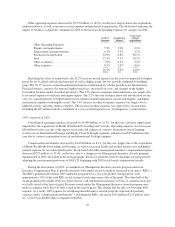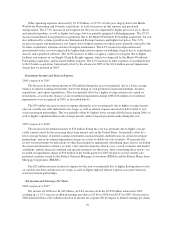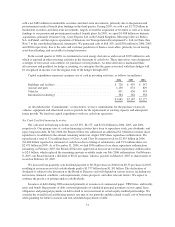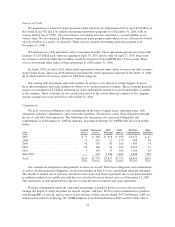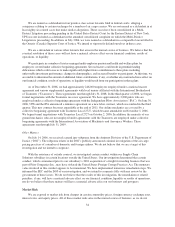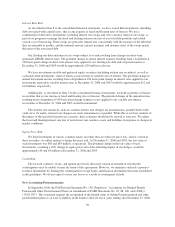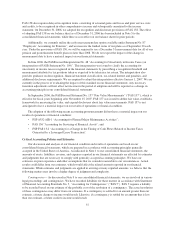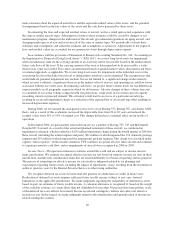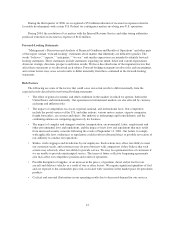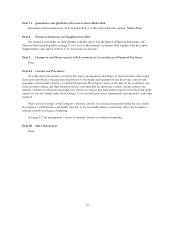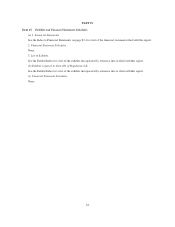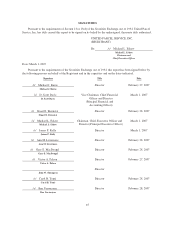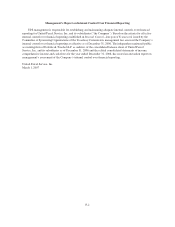UPS 2006 Annual Report Download - page 52
Download and view the complete annual report
Please find page 52 of the 2006 UPS annual report below. You can navigate through the pages in the report by either clicking on the pages listed below, or by using the keyword search tool below to find specific information within the annual report.FAS 158 also requires delayed recognition items, consisting of actuarial gains and losses and prior service costs
and credits, to be recognized in other comprehensive income and subsequently amortized to the income
statement. On December 31, 2006, we adopted the recognition and disclosure provisions of FAS 158. The effect
of adopting FAS 158 on our balance sheet as of December 31, 2006 has been included in Note 5 to the
consolidated financial statements, while there was no effect on our balance sheet for prior periods.
Additionally, we currently utilize the early measurement date option available under Statement No. 87
“Employers’ Accounting for Pensions”, and we measure the funded status of our plans as of September 30 each
year. Under the provisions of FAS 158, we will be required to use a December 31 measurement date for all of our
pension and postretirement benefit plans no later than 2008. We do not expect the impact of the change in
measurement date to have a material impact on our financial statements.
In June 2006, the FASB issued Interpretation No. 48 “Accounting for Uncertainty in Income Taxes (an
interpretation of FASB Statement No. 109)”. This interpretation was issued to clarify the accounting for
uncertainty in income taxes recognized in the financial statements by prescribing a recognition threshold and
measurement attribute for tax positions taken or expected to be taken in a tax return. The interpretation also
provides guidance on derecognition, financial statement classification, tax-related interest and penalties, and
additional disclosure requirements. We are required to adopt this interpretation effective January 1, 2007. We are
currently in the process of evaluating the impact of this standard on our financial statements. Any necessary
transition adjustments will not affect net income in the period of adoption and will be reported as a change in
accounting principle in our consolidated financial statements.
In September 2006, the FASB issued Statement No. 157 “Fair Value Measurements” (“FAS 157”), which is
effective for fiscal years beginning after November 15, 2007. FAS 157 was issued to define fair value, establish a
framework for measuring fair value, and expand disclosures about fair value measurements. FAS 157 is not
anticipated to have a material impact on our results of operations or financial condition.
The adoption of the following recent accounting pronouncements did not have a material impact on our
results of operations or financial condition:
• FSP AUG AIR-1 “Accounting for Planned Major Maintenance Activities”;
• FAS 156 “Accounting for Servicing of Financial Assets”; and
• FSP FAS 13-2 “Accounting for a Change in the Timing of Cash Flows Related to Income Taxes
Generated by a Leveraged Lease Transaction”.
Critical Accounting Policies and Estimates
Our discussion and analysis of our financial condition and results of operations are based on our
consolidated financial statements, which are prepared in accordance with accounting principles generally
accepted in the United States of America. As indicated in Note 1 to our consolidated financial statements, the
amounts of assets, liabilities, revenue, and expenses reported in our financial statements are affected by estimates
and judgments that are necessary to comply with generally accepted accounting principles. We base our
estimates on prior experience and other assumptions that we consider reasonable to our circumstances. Actual
results could differ from our estimates, which would affect the related amounts reported in our financial
statements. While estimates and judgments are applied in arriving at many reported amounts, we believe that the
following matters may involve a higher degree of judgment and complexity.
Contingencies— As discussed in Note 9 to our consolidated financial statements, we are involved in various
legal proceedings and contingencies. We have recorded liabilities for these matters in accordance with Statement
of Financial Accounting Standards No. 5, “Accounting for Contingencies” (“FAS 5”). FAS 5 requires a liability
to be recorded based on our estimate of the probable cost of the resolution of a contingency. The actual resolution
of these contingencies may differ from our estimates. If a contingency is settled for an amount greater than our
estimate, a future charge to income would result. Likewise, if a contingency is settled for an amount that is less
than our estimate, a future credit to income would result.
37



